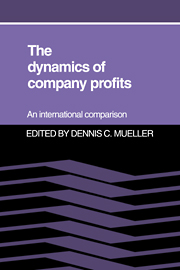Book contents
- Frontmatter
- Contents
- Preface
- Contributors
- 1 Profits and the process of competition
- 2 Modeling persistent profitability
- 3 The persistence of profits in the United States
- 4 The persistence of profits in U.S. manufacturing industries
- 5 The persistence of profitability in Canada
- 6 The persistence of corporate profits in the Federal Republic of Germany
- 7 The persistence of profits in France
- 8 The persistence of profits in Japan
- 9 The persistence of profits in the United Kingdom
- 10 The persistence of profits: international comparison
- 11 The persistence of profits in perspective
- References
- Index
8 - The persistence of profits in Japan
Published online by Cambridge University Press: 03 May 2010
- Frontmatter
- Contents
- Preface
- Contributors
- 1 Profits and the process of competition
- 2 Modeling persistent profitability
- 3 The persistence of profits in the United States
- 4 The persistence of profits in U.S. manufacturing industries
- 5 The persistence of profitability in Canada
- 6 The persistence of corporate profits in the Federal Republic of Germany
- 7 The persistence of profits in France
- 8 The persistence of profits in Japan
- 9 The persistence of profits in the United Kingdom
- 10 The persistence of profits: international comparison
- 11 The persistence of profits in perspective
- References
- Index
Summary
This chapter reports the results of our study on the persistence of profits in Japan. It is separated into five sections. Section I discusses the movement of average profitability during a sample period, 1964–82. Section II presents our estimation results on the persistent differences in profit rates among Japanese firms. Section III examines the influences of market share and market concentration on the projected long-run profit rate and on the speed of adjustment toward this long-run rate. The results indicate that the long-run profit rate is more strongly affected by market share whereas the adjustment speed is more strongly affected by concentration. This suggests that the adjustment speed is more strongly influenced by industry or market characteristics. To examine this possibility further, we seek in Section IV the determinants of the adjustment speed at the industry level by assigning each firm into one of the 42 three-digit industries and calculating the industrial average of the adjustment speed. The adjustment speed is compared in a sample of matched U.S. and Japanese industries. Section V summarizes our findings.
Average profit rates during 1964–82
Table 8.1 shows the movement of profit rates in Japan during the period of our inquiry, 1964–82. In the first three columns are the profit rates reported in the Corporation Enterprise Survey (Ministry of Finance) and in the fourth column is the average profit rate of 376 firms in our sample (to be discussed in detail in the next section). All the profit rates are defined as the ratio of after-tax profits inclusive of interest payments to total assets.
- Type
- Chapter
- Information
- The Dynamics of Company Profits , pp. 129 - 146Publisher: Cambridge University PressPrint publication year: 1990
- 17
- Cited by



